Developing a Health Policy: Social Isolation and Elderly Australians
VerifiedAdded on 2023/04/17
|12
|3105
|181
Essay
AI Summary
This essay proposes a new health policy focused on establishing local public health networks to combat social isolation and loneliness among the elderly in Australia. It defines the policy's purpose as promoting well-being, choice, and a better quality of life for home-bound seniors. The policy addresses the significant health issues associated with social isolation, such as depression, cognitive impairment, and increased mortality risk, by emphasizing the importance of quality social connections and active community involvement. Implementation strategies include identifying high-risk individuals, fostering meaningful relationships through social support, and encouraging active participation in care. The essay highlights the necessity of collaborative efforts and integrated services to ensure the policy's compliance and effectiveness, ultimately aiming to improve the social inclusion and overall health outcomes for elderly Australians.
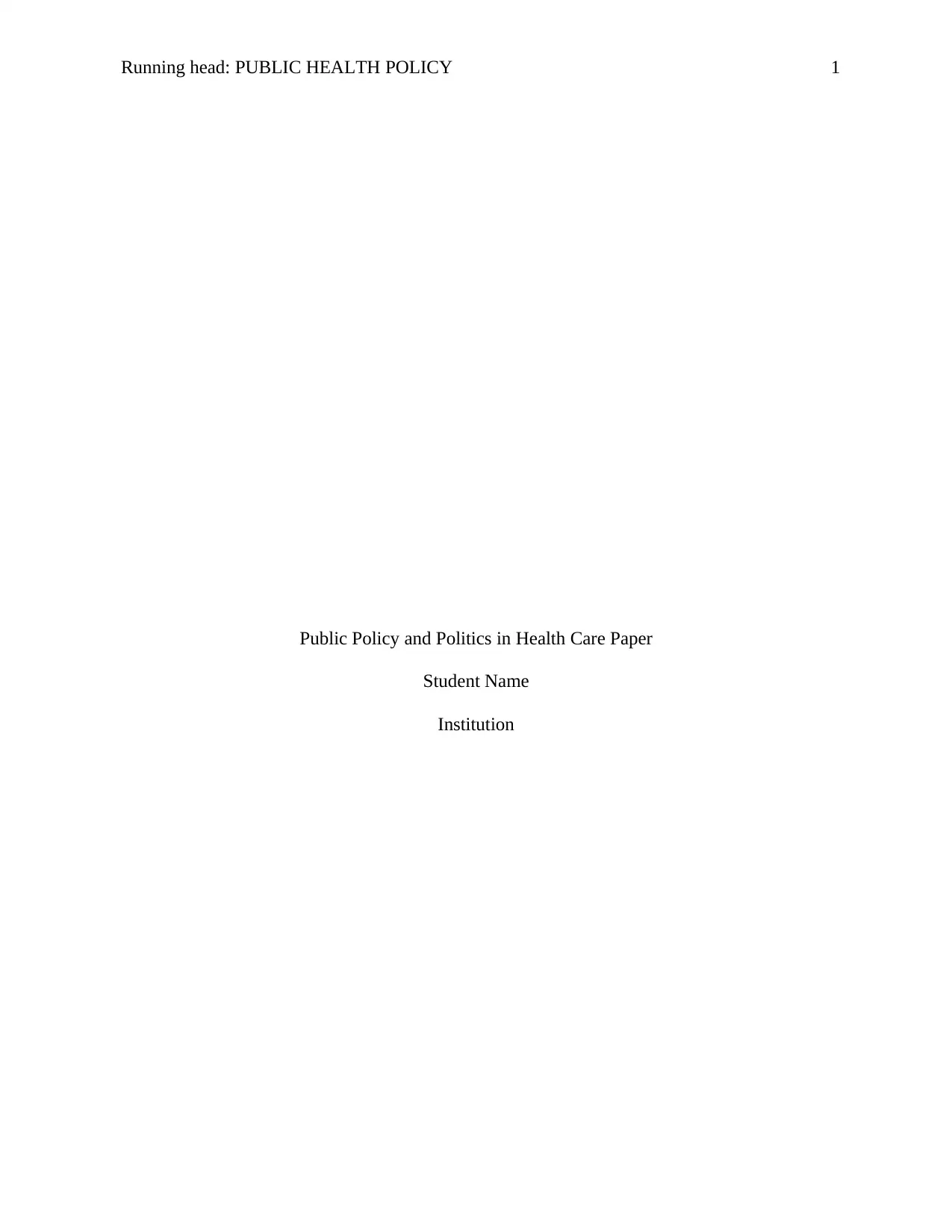
Running head: PUBLIC HEALTH POLICY 1
Public Policy and Politics in Health Care Paper
Student Name
Institution
Public Policy and Politics in Health Care Paper
Student Name
Institution
Paraphrase This Document
Need a fresh take? Get an instant paraphrase of this document with our AI Paraphraser
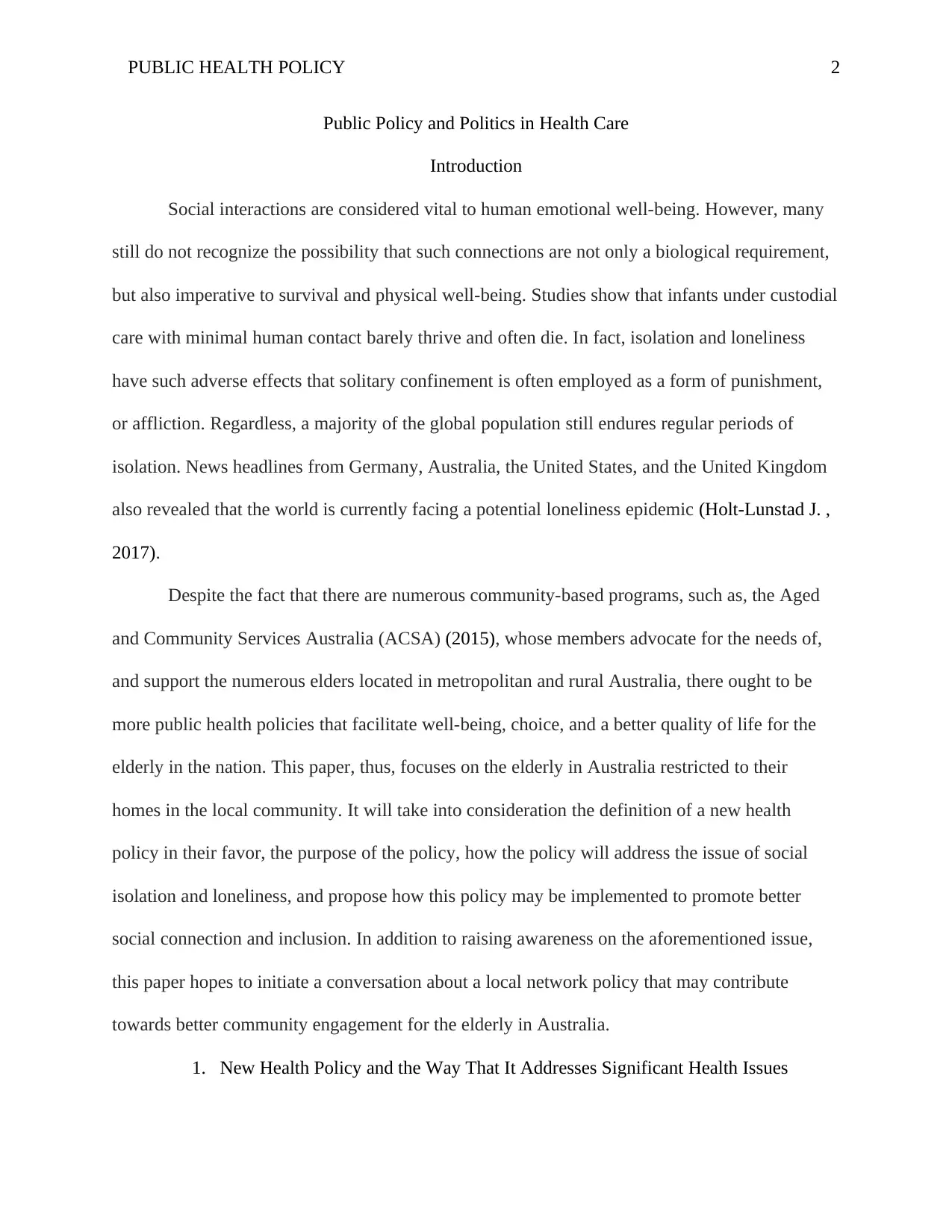
PUBLIC HEALTH POLICY 2
Public Policy and Politics in Health Care
Introduction
Social interactions are considered vital to human emotional well-being. However, many
still do not recognize the possibility that such connections are not only a biological requirement,
but also imperative to survival and physical well-being. Studies show that infants under custodial
care with minimal human contact barely thrive and often die. In fact, isolation and loneliness
have such adverse effects that solitary confinement is often employed as a form of punishment,
or affliction. Regardless, a majority of the global population still endures regular periods of
isolation. News headlines from Germany, Australia, the United States, and the United Kingdom
also revealed that the world is currently facing a potential loneliness epidemic (Holt-Lunstad J. ,
2017).
Despite the fact that there are numerous community-based programs, such as, the Aged
and Community Services Australia (ACSA) (2015), whose members advocate for the needs of,
and support the numerous elders located in metropolitan and rural Australia, there ought to be
more public health policies that facilitate well-being, choice, and a better quality of life for the
elderly in the nation. This paper, thus, focuses on the elderly in Australia restricted to their
homes in the local community. It will take into consideration the definition of a new health
policy in their favor, the purpose of the policy, how the policy will address the issue of social
isolation and loneliness, and propose how this policy may be implemented to promote better
social connection and inclusion. In addition to raising awareness on the aforementioned issue,
this paper hopes to initiate a conversation about a local network policy that may contribute
towards better community engagement for the elderly in Australia.
1. New Health Policy and the Way That It Addresses Significant Health Issues
Public Policy and Politics in Health Care
Introduction
Social interactions are considered vital to human emotional well-being. However, many
still do not recognize the possibility that such connections are not only a biological requirement,
but also imperative to survival and physical well-being. Studies show that infants under custodial
care with minimal human contact barely thrive and often die. In fact, isolation and loneliness
have such adverse effects that solitary confinement is often employed as a form of punishment,
or affliction. Regardless, a majority of the global population still endures regular periods of
isolation. News headlines from Germany, Australia, the United States, and the United Kingdom
also revealed that the world is currently facing a potential loneliness epidemic (Holt-Lunstad J. ,
2017).
Despite the fact that there are numerous community-based programs, such as, the Aged
and Community Services Australia (ACSA) (2015), whose members advocate for the needs of,
and support the numerous elders located in metropolitan and rural Australia, there ought to be
more public health policies that facilitate well-being, choice, and a better quality of life for the
elderly in the nation. This paper, thus, focuses on the elderly in Australia restricted to their
homes in the local community. It will take into consideration the definition of a new health
policy in their favor, the purpose of the policy, how the policy will address the issue of social
isolation and loneliness, and propose how this policy may be implemented to promote better
social connection and inclusion. In addition to raising awareness on the aforementioned issue,
this paper hopes to initiate a conversation about a local network policy that may contribute
towards better community engagement for the elderly in Australia.
1. New Health Policy and the Way That It Addresses Significant Health Issues
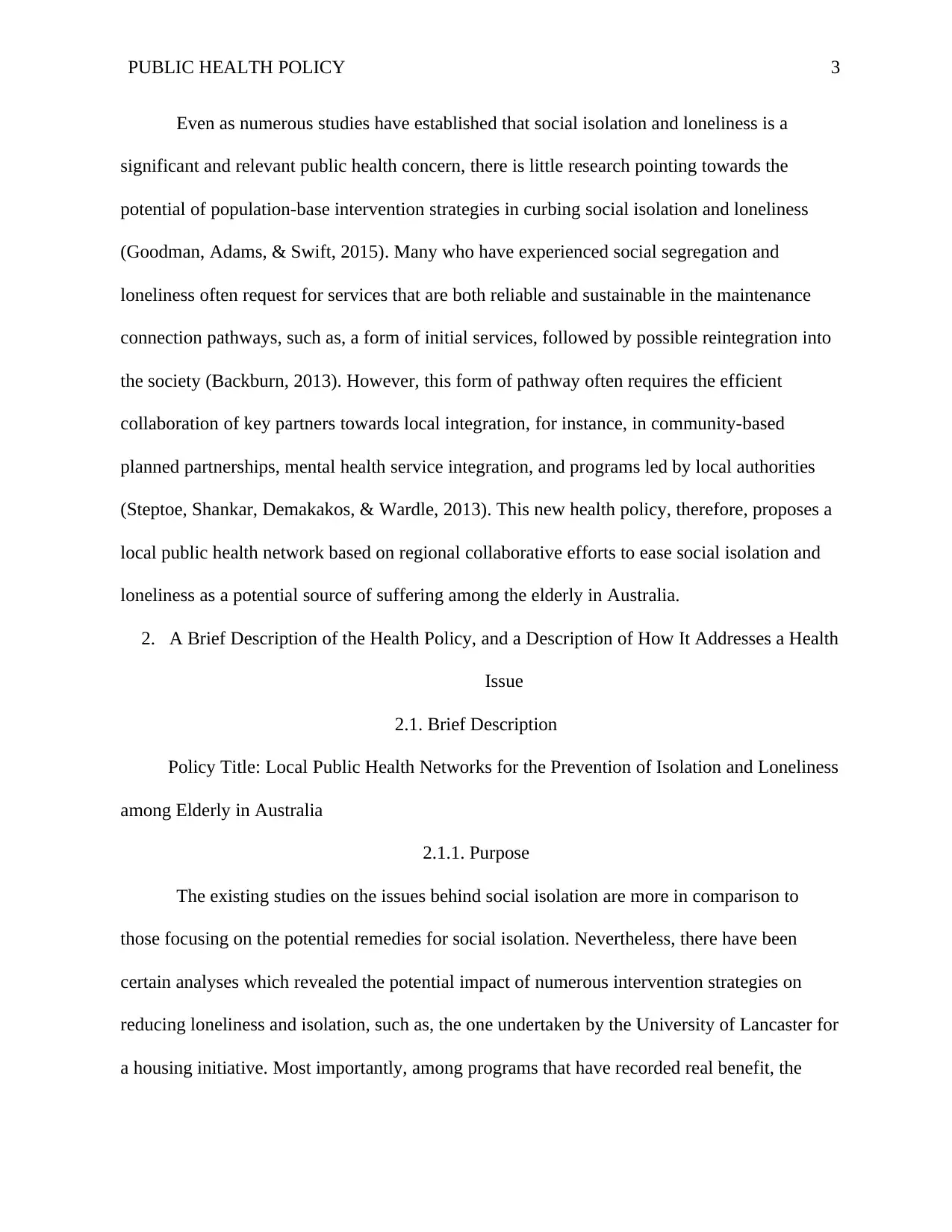
PUBLIC HEALTH POLICY 3
Even as numerous studies have established that social isolation and loneliness is a
significant and relevant public health concern, there is little research pointing towards the
potential of population-base intervention strategies in curbing social isolation and loneliness
(Goodman, Adams, & Swift, 2015). Many who have experienced social segregation and
loneliness often request for services that are both reliable and sustainable in the maintenance
connection pathways, such as, a form of initial services, followed by possible reintegration into
the society (Backburn, 2013). However, this form of pathway often requires the efficient
collaboration of key partners towards local integration, for instance, in community-based
planned partnerships, mental health service integration, and programs led by local authorities
(Steptoe, Shankar, Demakakos, & Wardle, 2013). This new health policy, therefore, proposes a
local public health network based on regional collaborative efforts to ease social isolation and
loneliness as a potential source of suffering among the elderly in Australia.
2. A Brief Description of the Health Policy, and a Description of How It Addresses a Health
Issue
2.1. Brief Description
Policy Title: Local Public Health Networks for the Prevention of Isolation and Loneliness
among Elderly in Australia
2.1.1. Purpose
The existing studies on the issues behind social isolation are more in comparison to
those focusing on the potential remedies for social isolation. Nevertheless, there have been
certain analyses which revealed the potential impact of numerous intervention strategies on
reducing loneliness and isolation, such as, the one undertaken by the University of Lancaster for
a housing initiative. Most importantly, among programs that have recorded real benefit, the
Even as numerous studies have established that social isolation and loneliness is a
significant and relevant public health concern, there is little research pointing towards the
potential of population-base intervention strategies in curbing social isolation and loneliness
(Goodman, Adams, & Swift, 2015). Many who have experienced social segregation and
loneliness often request for services that are both reliable and sustainable in the maintenance
connection pathways, such as, a form of initial services, followed by possible reintegration into
the society (Backburn, 2013). However, this form of pathway often requires the efficient
collaboration of key partners towards local integration, for instance, in community-based
planned partnerships, mental health service integration, and programs led by local authorities
(Steptoe, Shankar, Demakakos, & Wardle, 2013). This new health policy, therefore, proposes a
local public health network based on regional collaborative efforts to ease social isolation and
loneliness as a potential source of suffering among the elderly in Australia.
2. A Brief Description of the Health Policy, and a Description of How It Addresses a Health
Issue
2.1. Brief Description
Policy Title: Local Public Health Networks for the Prevention of Isolation and Loneliness
among Elderly in Australia
2.1.1. Purpose
The existing studies on the issues behind social isolation are more in comparison to
those focusing on the potential remedies for social isolation. Nevertheless, there have been
certain analyses which revealed the potential impact of numerous intervention strategies on
reducing loneliness and isolation, such as, the one undertaken by the University of Lancaster for
a housing initiative. Most importantly, among programs that have recorded real benefit, the
⊘ This is a preview!⊘
Do you want full access?
Subscribe today to unlock all pages.

Trusted by 1+ million students worldwide
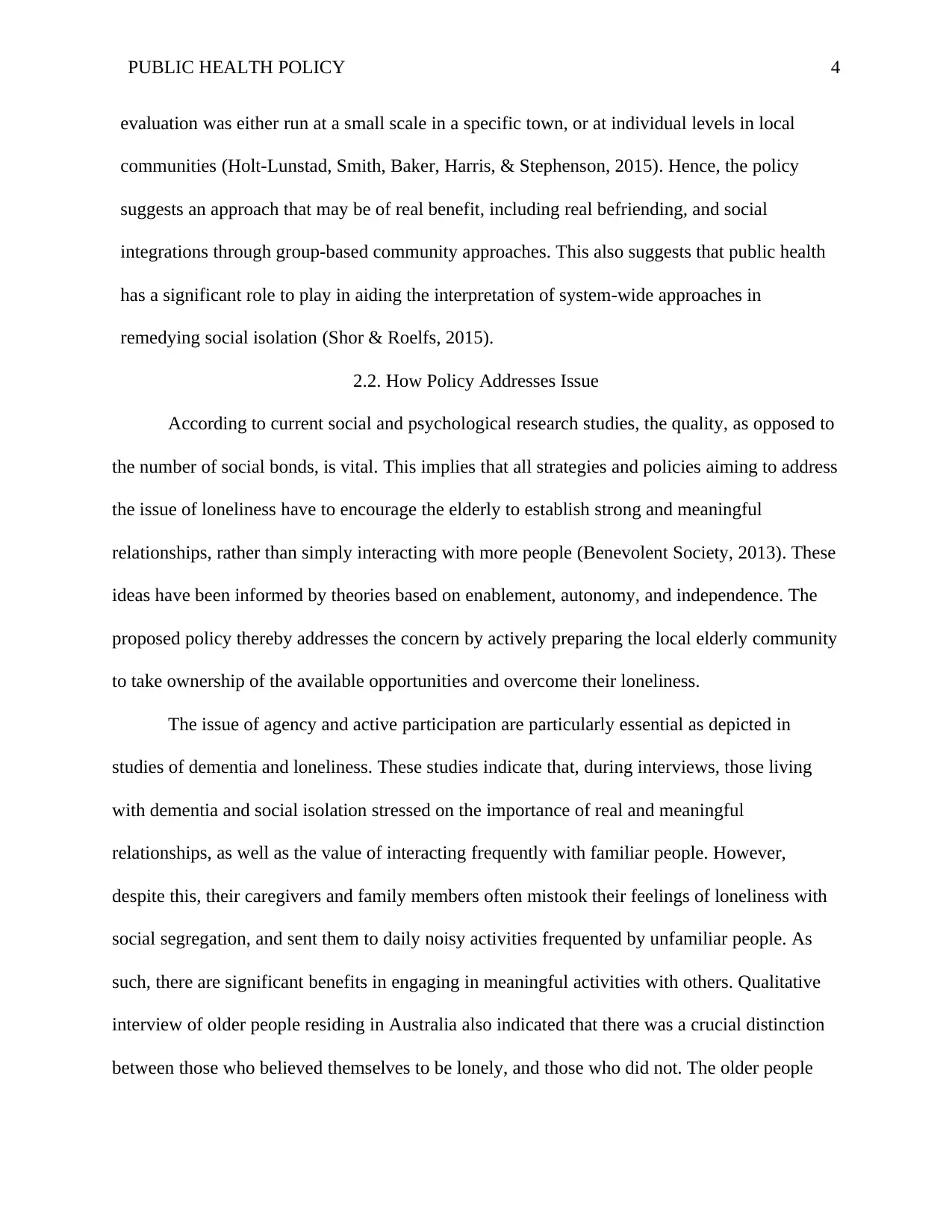
PUBLIC HEALTH POLICY 4
evaluation was either run at a small scale in a specific town, or at individual levels in local
communities (Holt-Lunstad, Smith, Baker, Harris, & Stephenson, 2015). Hence, the policy
suggests an approach that may be of real benefit, including real befriending, and social
integrations through group-based community approaches. This also suggests that public health
has a significant role to play in aiding the interpretation of system-wide approaches in
remedying social isolation (Shor & Roelfs, 2015).
2.2. How Policy Addresses Issue
According to current social and psychological research studies, the quality, as opposed to
the number of social bonds, is vital. This implies that all strategies and policies aiming to address
the issue of loneliness have to encourage the elderly to establish strong and meaningful
relationships, rather than simply interacting with more people (Benevolent Society, 2013). These
ideas have been informed by theories based on enablement, autonomy, and independence. The
proposed policy thereby addresses the concern by actively preparing the local elderly community
to take ownership of the available opportunities and overcome their loneliness.
The issue of agency and active participation are particularly essential as depicted in
studies of dementia and loneliness. These studies indicate that, during interviews, those living
with dementia and social isolation stressed on the importance of real and meaningful
relationships, as well as the value of interacting frequently with familiar people. However,
despite this, their caregivers and family members often mistook their feelings of loneliness with
social segregation, and sent them to daily noisy activities frequented by unfamiliar people. As
such, there are significant benefits in engaging in meaningful activities with others. Qualitative
interview of older people residing in Australia also indicated that there was a crucial distinction
between those who believed themselves to be lonely, and those who did not. The older people
evaluation was either run at a small scale in a specific town, or at individual levels in local
communities (Holt-Lunstad, Smith, Baker, Harris, & Stephenson, 2015). Hence, the policy
suggests an approach that may be of real benefit, including real befriending, and social
integrations through group-based community approaches. This also suggests that public health
has a significant role to play in aiding the interpretation of system-wide approaches in
remedying social isolation (Shor & Roelfs, 2015).
2.2. How Policy Addresses Issue
According to current social and psychological research studies, the quality, as opposed to
the number of social bonds, is vital. This implies that all strategies and policies aiming to address
the issue of loneliness have to encourage the elderly to establish strong and meaningful
relationships, rather than simply interacting with more people (Benevolent Society, 2013). These
ideas have been informed by theories based on enablement, autonomy, and independence. The
proposed policy thereby addresses the concern by actively preparing the local elderly community
to take ownership of the available opportunities and overcome their loneliness.
The issue of agency and active participation are particularly essential as depicted in
studies of dementia and loneliness. These studies indicate that, during interviews, those living
with dementia and social isolation stressed on the importance of real and meaningful
relationships, as well as the value of interacting frequently with familiar people. However,
despite this, their caregivers and family members often mistook their feelings of loneliness with
social segregation, and sent them to daily noisy activities frequented by unfamiliar people. As
such, there are significant benefits in engaging in meaningful activities with others. Qualitative
interview of older people residing in Australia also indicated that there was a crucial distinction
between those who believed themselves to be lonely, and those who did not. The older people
Paraphrase This Document
Need a fresh take? Get an instant paraphrase of this document with our AI Paraphraser
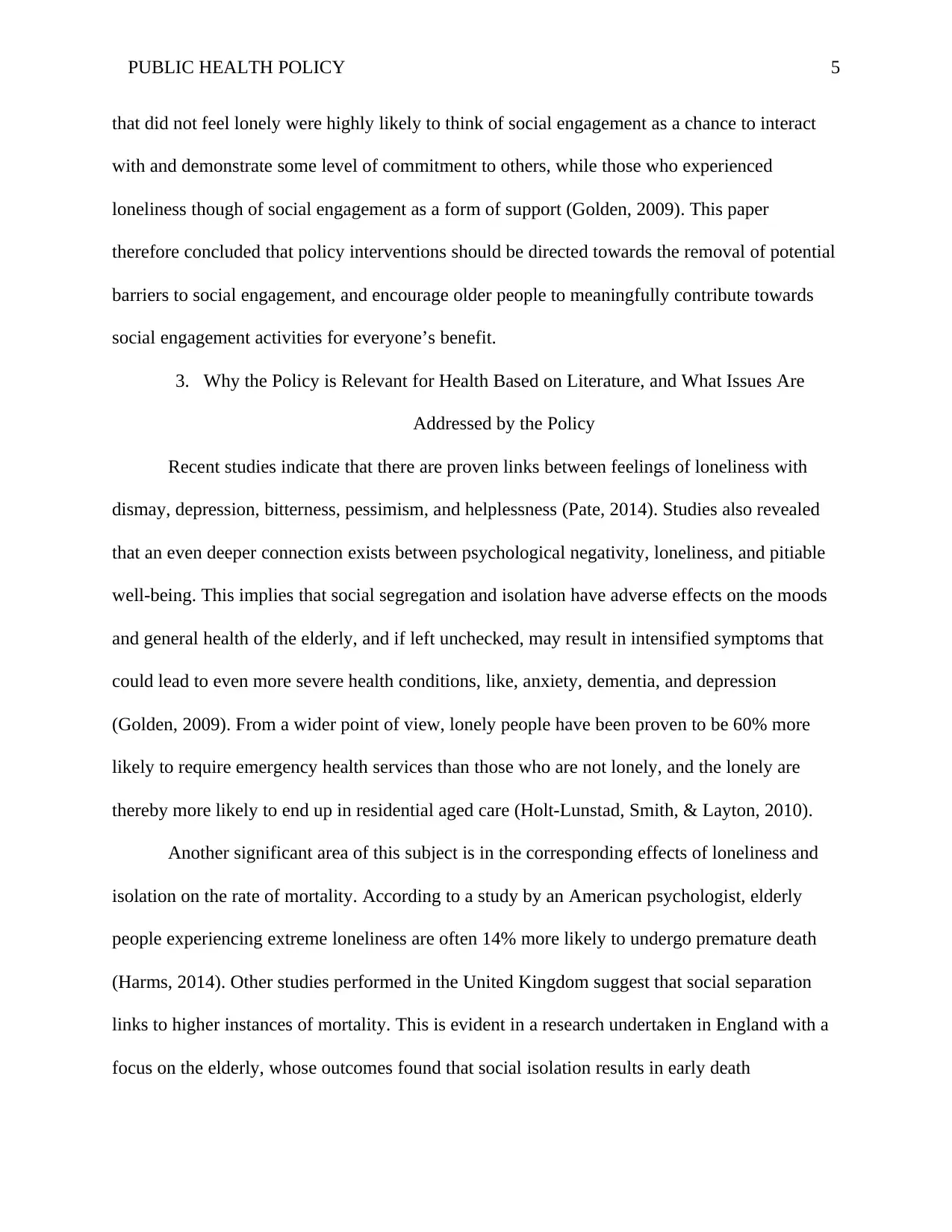
PUBLIC HEALTH POLICY 5
that did not feel lonely were highly likely to think of social engagement as a chance to interact
with and demonstrate some level of commitment to others, while those who experienced
loneliness though of social engagement as a form of support (Golden, 2009). This paper
therefore concluded that policy interventions should be directed towards the removal of potential
barriers to social engagement, and encourage older people to meaningfully contribute towards
social engagement activities for everyone’s benefit.
3. Why the Policy is Relevant for Health Based on Literature, and What Issues Are
Addressed by the Policy
Recent studies indicate that there are proven links between feelings of loneliness with
dismay, depression, bitterness, pessimism, and helplessness (Pate, 2014). Studies also revealed
that an even deeper connection exists between psychological negativity, loneliness, and pitiable
well-being. This implies that social segregation and isolation have adverse effects on the moods
and general health of the elderly, and if left unchecked, may result in intensified symptoms that
could lead to even more severe health conditions, like, anxiety, dementia, and depression
(Golden, 2009). From a wider point of view, lonely people have been proven to be 60% more
likely to require emergency health services than those who are not lonely, and the lonely are
thereby more likely to end up in residential aged care (Holt-Lunstad, Smith, & Layton, 2010).
Another significant area of this subject is in the corresponding effects of loneliness and
isolation on the rate of mortality. According to a study by an American psychologist, elderly
people experiencing extreme loneliness are often 14% more likely to undergo premature death
(Harms, 2014). Other studies performed in the United Kingdom suggest that social separation
links to higher instances of mortality. This is evident in a research undertaken in England with a
focus on the elderly, whose outcomes found that social isolation results in early death
that did not feel lonely were highly likely to think of social engagement as a chance to interact
with and demonstrate some level of commitment to others, while those who experienced
loneliness though of social engagement as a form of support (Golden, 2009). This paper
therefore concluded that policy interventions should be directed towards the removal of potential
barriers to social engagement, and encourage older people to meaningfully contribute towards
social engagement activities for everyone’s benefit.
3. Why the Policy is Relevant for Health Based on Literature, and What Issues Are
Addressed by the Policy
Recent studies indicate that there are proven links between feelings of loneliness with
dismay, depression, bitterness, pessimism, and helplessness (Pate, 2014). Studies also revealed
that an even deeper connection exists between psychological negativity, loneliness, and pitiable
well-being. This implies that social segregation and isolation have adverse effects on the moods
and general health of the elderly, and if left unchecked, may result in intensified symptoms that
could lead to even more severe health conditions, like, anxiety, dementia, and depression
(Golden, 2009). From a wider point of view, lonely people have been proven to be 60% more
likely to require emergency health services than those who are not lonely, and the lonely are
thereby more likely to end up in residential aged care (Holt-Lunstad, Smith, & Layton, 2010).
Another significant area of this subject is in the corresponding effects of loneliness and
isolation on the rate of mortality. According to a study by an American psychologist, elderly
people experiencing extreme loneliness are often 14% more likely to undergo premature death
(Harms, 2014). Other studies performed in the United Kingdom suggest that social separation
links to higher instances of mortality. This is evident in a research undertaken in England with a
focus on the elderly, whose outcomes found that social isolation results in early death
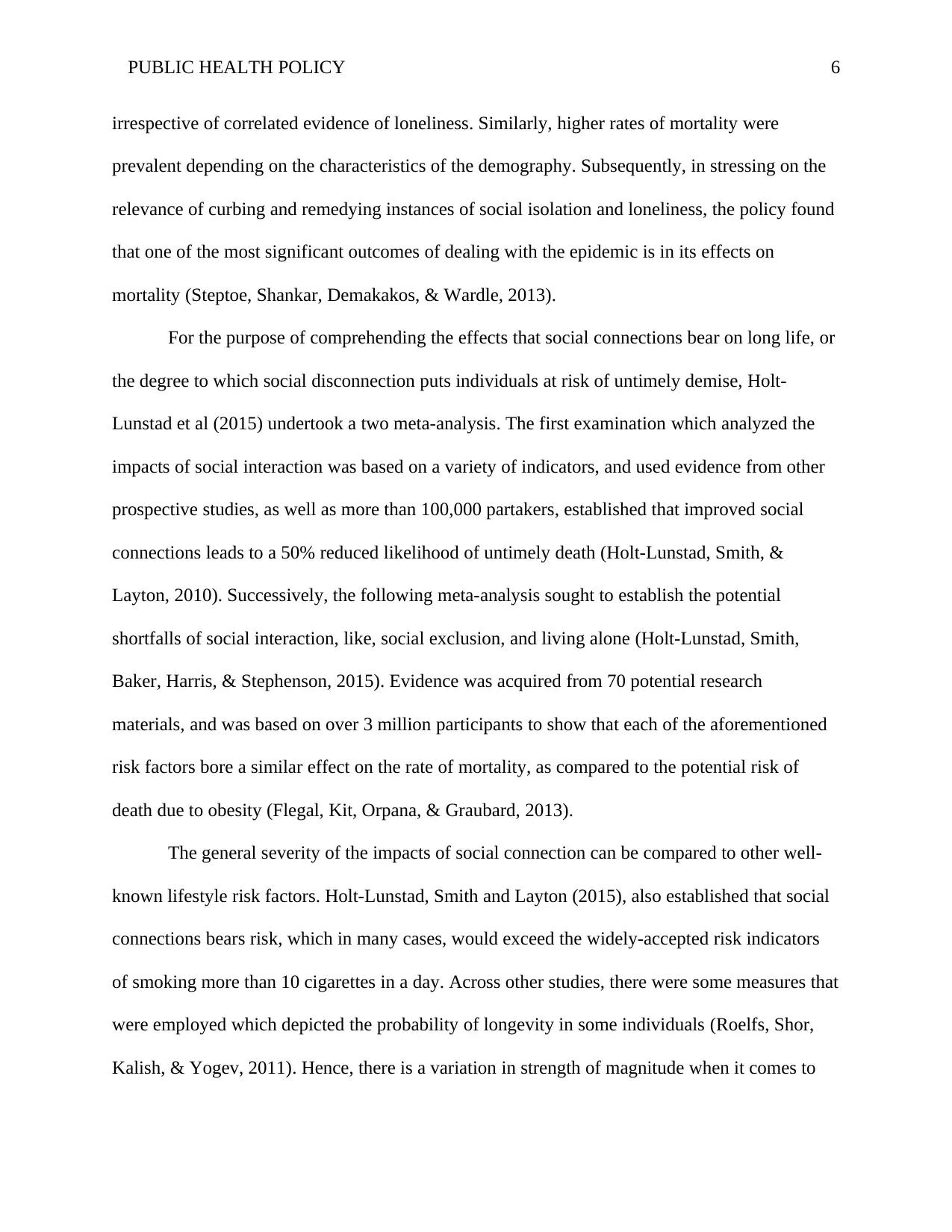
PUBLIC HEALTH POLICY 6
irrespective of correlated evidence of loneliness. Similarly, higher rates of mortality were
prevalent depending on the characteristics of the demography. Subsequently, in stressing on the
relevance of curbing and remedying instances of social isolation and loneliness, the policy found
that one of the most significant outcomes of dealing with the epidemic is in its effects on
mortality (Steptoe, Shankar, Demakakos, & Wardle, 2013).
For the purpose of comprehending the effects that social connections bear on long life, or
the degree to which social disconnection puts individuals at risk of untimely demise, Holt-
Lunstad et al (2015) undertook a two meta-analysis. The first examination which analyzed the
impacts of social interaction was based on a variety of indicators, and used evidence from other
prospective studies, as well as more than 100,000 partakers, established that improved social
connections leads to a 50% reduced likelihood of untimely death (Holt-Lunstad, Smith, &
Layton, 2010). Successively, the following meta-analysis sought to establish the potential
shortfalls of social interaction, like, social exclusion, and living alone (Holt-Lunstad, Smith,
Baker, Harris, & Stephenson, 2015). Evidence was acquired from 70 potential research
materials, and was based on over 3 million participants to show that each of the aforementioned
risk factors bore a similar effect on the rate of mortality, as compared to the potential risk of
death due to obesity (Flegal, Kit, Orpana, & Graubard, 2013).
The general severity of the impacts of social connection can be compared to other well-
known lifestyle risk factors. Holt-Lunstad, Smith and Layton (2015), also established that social
connections bears risk, which in many cases, would exceed the widely-accepted risk indicators
of smoking more than 10 cigarettes in a day. Across other studies, there were some measures that
were employed which depicted the probability of longevity in some individuals (Roelfs, Shor,
Kalish, & Yogev, 2011). Hence, there is a variation in strength of magnitude when it comes to
irrespective of correlated evidence of loneliness. Similarly, higher rates of mortality were
prevalent depending on the characteristics of the demography. Subsequently, in stressing on the
relevance of curbing and remedying instances of social isolation and loneliness, the policy found
that one of the most significant outcomes of dealing with the epidemic is in its effects on
mortality (Steptoe, Shankar, Demakakos, & Wardle, 2013).
For the purpose of comprehending the effects that social connections bear on long life, or
the degree to which social disconnection puts individuals at risk of untimely demise, Holt-
Lunstad et al (2015) undertook a two meta-analysis. The first examination which analyzed the
impacts of social interaction was based on a variety of indicators, and used evidence from other
prospective studies, as well as more than 100,000 partakers, established that improved social
connections leads to a 50% reduced likelihood of untimely death (Holt-Lunstad, Smith, &
Layton, 2010). Successively, the following meta-analysis sought to establish the potential
shortfalls of social interaction, like, social exclusion, and living alone (Holt-Lunstad, Smith,
Baker, Harris, & Stephenson, 2015). Evidence was acquired from 70 potential research
materials, and was based on over 3 million participants to show that each of the aforementioned
risk factors bore a similar effect on the rate of mortality, as compared to the potential risk of
death due to obesity (Flegal, Kit, Orpana, & Graubard, 2013).
The general severity of the impacts of social connection can be compared to other well-
known lifestyle risk factors. Holt-Lunstad, Smith and Layton (2015), also established that social
connections bears risk, which in many cases, would exceed the widely-accepted risk indicators
of smoking more than 10 cigarettes in a day. Across other studies, there were some measures that
were employed which depicted the probability of longevity in some individuals (Roelfs, Shor,
Kalish, & Yogev, 2011). Hence, there is a variation in strength of magnitude when it comes to
⊘ This is a preview!⊘
Do you want full access?
Subscribe today to unlock all pages.

Trusted by 1+ million students worldwide
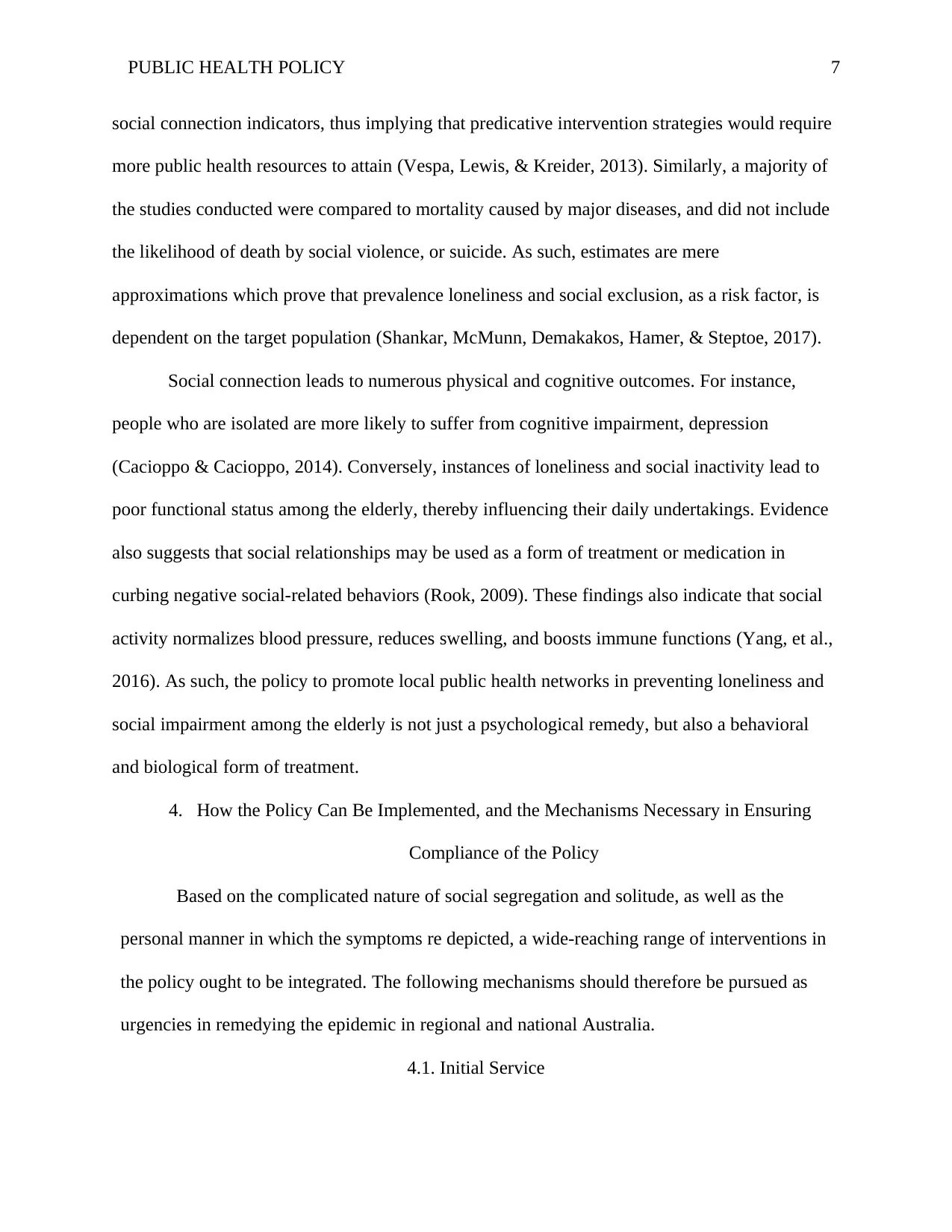
PUBLIC HEALTH POLICY 7
social connection indicators, thus implying that predicative intervention strategies would require
more public health resources to attain (Vespa, Lewis, & Kreider, 2013). Similarly, a majority of
the studies conducted were compared to mortality caused by major diseases, and did not include
the likelihood of death by social violence, or suicide. As such, estimates are mere
approximations which prove that prevalence loneliness and social exclusion, as a risk factor, is
dependent on the target population (Shankar, McMunn, Demakakos, Hamer, & Steptoe, 2017).
Social connection leads to numerous physical and cognitive outcomes. For instance,
people who are isolated are more likely to suffer from cognitive impairment, depression
(Cacioppo & Cacioppo, 2014). Conversely, instances of loneliness and social inactivity lead to
poor functional status among the elderly, thereby influencing their daily undertakings. Evidence
also suggests that social relationships may be used as a form of treatment or medication in
curbing negative social-related behaviors (Rook, 2009). These findings also indicate that social
activity normalizes blood pressure, reduces swelling, and boosts immune functions (Yang, et al.,
2016). As such, the policy to promote local public health networks in preventing loneliness and
social impairment among the elderly is not just a psychological remedy, but also a behavioral
and biological form of treatment.
4. How the Policy Can Be Implemented, and the Mechanisms Necessary in Ensuring
Compliance of the Policy
Based on the complicated nature of social segregation and solitude, as well as the
personal manner in which the symptoms re depicted, a wide-reaching range of interventions in
the policy ought to be integrated. The following mechanisms should therefore be pursued as
urgencies in remedying the epidemic in regional and national Australia.
4.1. Initial Service
social connection indicators, thus implying that predicative intervention strategies would require
more public health resources to attain (Vespa, Lewis, & Kreider, 2013). Similarly, a majority of
the studies conducted were compared to mortality caused by major diseases, and did not include
the likelihood of death by social violence, or suicide. As such, estimates are mere
approximations which prove that prevalence loneliness and social exclusion, as a risk factor, is
dependent on the target population (Shankar, McMunn, Demakakos, Hamer, & Steptoe, 2017).
Social connection leads to numerous physical and cognitive outcomes. For instance,
people who are isolated are more likely to suffer from cognitive impairment, depression
(Cacioppo & Cacioppo, 2014). Conversely, instances of loneliness and social inactivity lead to
poor functional status among the elderly, thereby influencing their daily undertakings. Evidence
also suggests that social relationships may be used as a form of treatment or medication in
curbing negative social-related behaviors (Rook, 2009). These findings also indicate that social
activity normalizes blood pressure, reduces swelling, and boosts immune functions (Yang, et al.,
2016). As such, the policy to promote local public health networks in preventing loneliness and
social impairment among the elderly is not just a psychological remedy, but also a behavioral
and biological form of treatment.
4. How the Policy Can Be Implemented, and the Mechanisms Necessary in Ensuring
Compliance of the Policy
Based on the complicated nature of social segregation and solitude, as well as the
personal manner in which the symptoms re depicted, a wide-reaching range of interventions in
the policy ought to be integrated. The following mechanisms should therefore be pursued as
urgencies in remedying the epidemic in regional and national Australia.
4.1. Initial Service
Paraphrase This Document
Need a fresh take? Get an instant paraphrase of this document with our AI Paraphraser
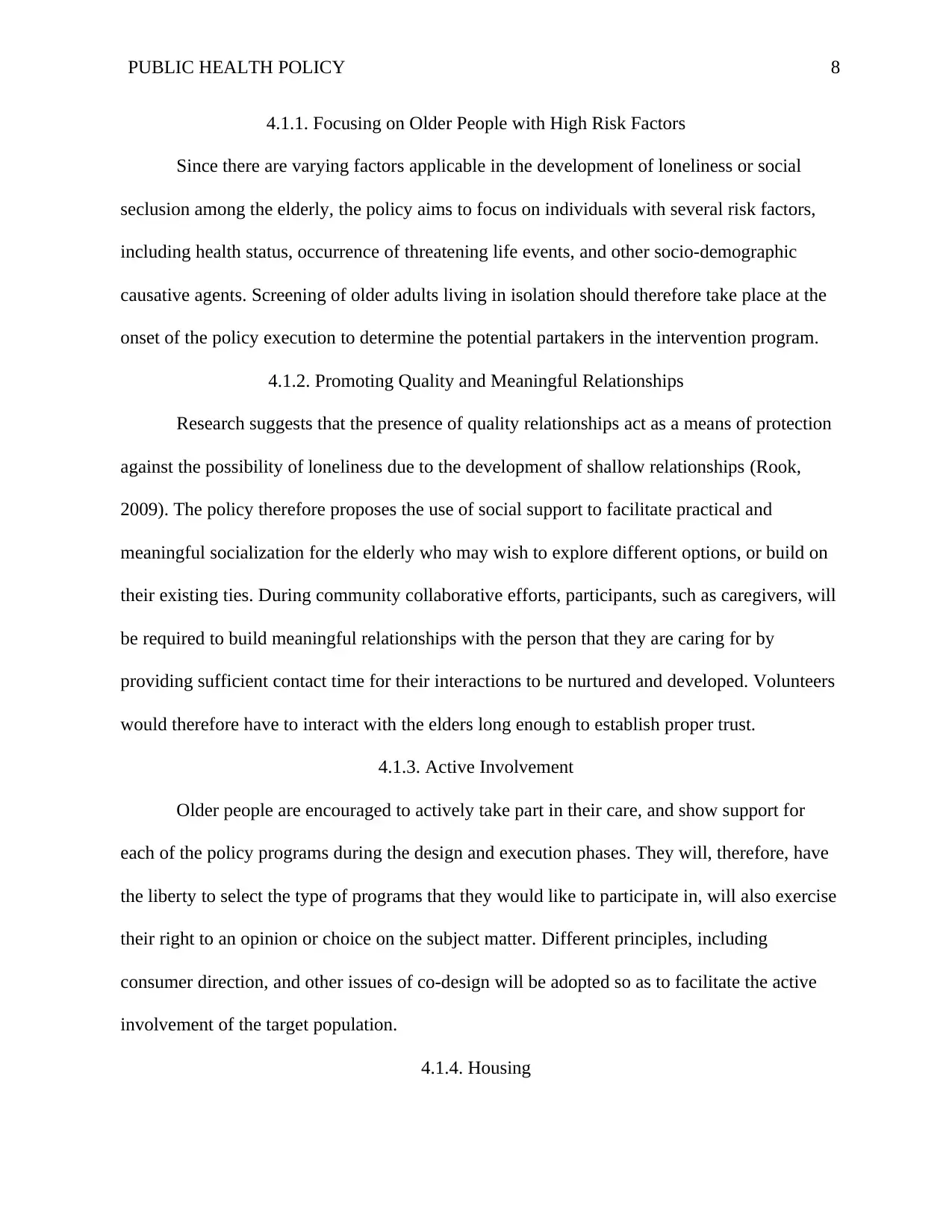
PUBLIC HEALTH POLICY 8
4.1.1. Focusing on Older People with High Risk Factors
Since there are varying factors applicable in the development of loneliness or social
seclusion among the elderly, the policy aims to focus on individuals with several risk factors,
including health status, occurrence of threatening life events, and other socio-demographic
causative agents. Screening of older adults living in isolation should therefore take place at the
onset of the policy execution to determine the potential partakers in the intervention program.
4.1.2. Promoting Quality and Meaningful Relationships
Research suggests that the presence of quality relationships act as a means of protection
against the possibility of loneliness due to the development of shallow relationships (Rook,
2009). The policy therefore proposes the use of social support to facilitate practical and
meaningful socialization for the elderly who may wish to explore different options, or build on
their existing ties. During community collaborative efforts, participants, such as caregivers, will
be required to build meaningful relationships with the person that they are caring for by
providing sufficient contact time for their interactions to be nurtured and developed. Volunteers
would therefore have to interact with the elders long enough to establish proper trust.
4.1.3. Active Involvement
Older people are encouraged to actively take part in their care, and show support for
each of the policy programs during the design and execution phases. They will, therefore, have
the liberty to select the type of programs that they would like to participate in, will also exercise
their right to an opinion or choice on the subject matter. Different principles, including
consumer direction, and other issues of co-design will be adopted so as to facilitate the active
involvement of the target population.
4.1.4. Housing
4.1.1. Focusing on Older People with High Risk Factors
Since there are varying factors applicable in the development of loneliness or social
seclusion among the elderly, the policy aims to focus on individuals with several risk factors,
including health status, occurrence of threatening life events, and other socio-demographic
causative agents. Screening of older adults living in isolation should therefore take place at the
onset of the policy execution to determine the potential partakers in the intervention program.
4.1.2. Promoting Quality and Meaningful Relationships
Research suggests that the presence of quality relationships act as a means of protection
against the possibility of loneliness due to the development of shallow relationships (Rook,
2009). The policy therefore proposes the use of social support to facilitate practical and
meaningful socialization for the elderly who may wish to explore different options, or build on
their existing ties. During community collaborative efforts, participants, such as caregivers, will
be required to build meaningful relationships with the person that they are caring for by
providing sufficient contact time for their interactions to be nurtured and developed. Volunteers
would therefore have to interact with the elders long enough to establish proper trust.
4.1.3. Active Involvement
Older people are encouraged to actively take part in their care, and show support for
each of the policy programs during the design and execution phases. They will, therefore, have
the liberty to select the type of programs that they would like to participate in, will also exercise
their right to an opinion or choice on the subject matter. Different principles, including
consumer direction, and other issues of co-design will be adopted so as to facilitate the active
involvement of the target population.
4.1.4. Housing
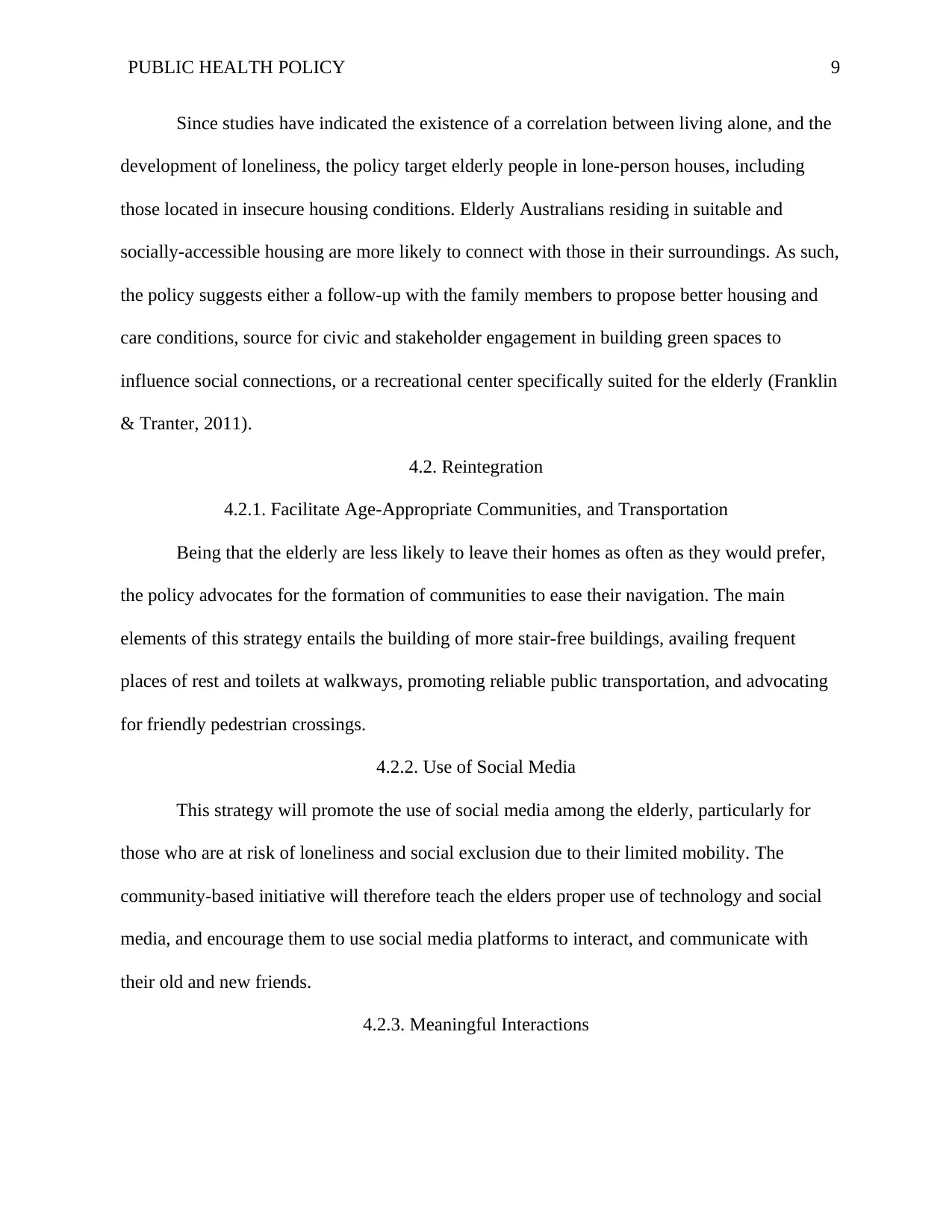
PUBLIC HEALTH POLICY 9
Since studies have indicated the existence of a correlation between living alone, and the
development of loneliness, the policy target elderly people in lone-person houses, including
those located in insecure housing conditions. Elderly Australians residing in suitable and
socially-accessible housing are more likely to connect with those in their surroundings. As such,
the policy suggests either a follow-up with the family members to propose better housing and
care conditions, source for civic and stakeholder engagement in building green spaces to
influence social connections, or a recreational center specifically suited for the elderly (Franklin
& Tranter, 2011).
4.2. Reintegration
4.2.1. Facilitate Age-Appropriate Communities, and Transportation
Being that the elderly are less likely to leave their homes as often as they would prefer,
the policy advocates for the formation of communities to ease their navigation. The main
elements of this strategy entails the building of more stair-free buildings, availing frequent
places of rest and toilets at walkways, promoting reliable public transportation, and advocating
for friendly pedestrian crossings.
4.2.2. Use of Social Media
This strategy will promote the use of social media among the elderly, particularly for
those who are at risk of loneliness and social exclusion due to their limited mobility. The
community-based initiative will therefore teach the elders proper use of technology and social
media, and encourage them to use social media platforms to interact, and communicate with
their old and new friends.
4.2.3. Meaningful Interactions
Since studies have indicated the existence of a correlation between living alone, and the
development of loneliness, the policy target elderly people in lone-person houses, including
those located in insecure housing conditions. Elderly Australians residing in suitable and
socially-accessible housing are more likely to connect with those in their surroundings. As such,
the policy suggests either a follow-up with the family members to propose better housing and
care conditions, source for civic and stakeholder engagement in building green spaces to
influence social connections, or a recreational center specifically suited for the elderly (Franklin
& Tranter, 2011).
4.2. Reintegration
4.2.1. Facilitate Age-Appropriate Communities, and Transportation
Being that the elderly are less likely to leave their homes as often as they would prefer,
the policy advocates for the formation of communities to ease their navigation. The main
elements of this strategy entails the building of more stair-free buildings, availing frequent
places of rest and toilets at walkways, promoting reliable public transportation, and advocating
for friendly pedestrian crossings.
4.2.2. Use of Social Media
This strategy will promote the use of social media among the elderly, particularly for
those who are at risk of loneliness and social exclusion due to their limited mobility. The
community-based initiative will therefore teach the elders proper use of technology and social
media, and encourage them to use social media platforms to interact, and communicate with
their old and new friends.
4.2.3. Meaningful Interactions
⊘ This is a preview!⊘
Do you want full access?
Subscribe today to unlock all pages.

Trusted by 1+ million students worldwide
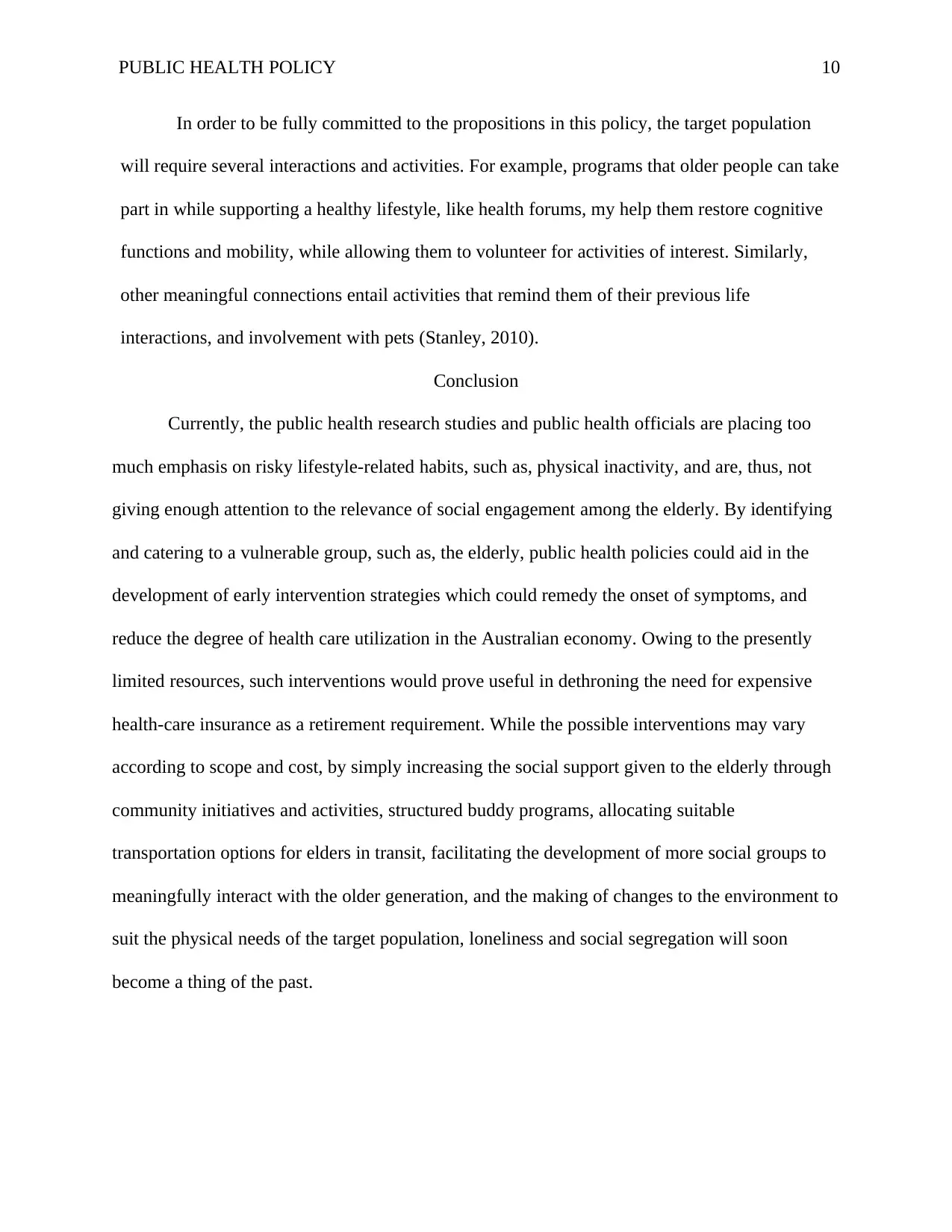
PUBLIC HEALTH POLICY 10
In order to be fully committed to the propositions in this policy, the target population
will require several interactions and activities. For example, programs that older people can take
part in while supporting a healthy lifestyle, like health forums, my help them restore cognitive
functions and mobility, while allowing them to volunteer for activities of interest. Similarly,
other meaningful connections entail activities that remind them of their previous life
interactions, and involvement with pets (Stanley, 2010).
Conclusion
Currently, the public health research studies and public health officials are placing too
much emphasis on risky lifestyle-related habits, such as, physical inactivity, and are, thus, not
giving enough attention to the relevance of social engagement among the elderly. By identifying
and catering to a vulnerable group, such as, the elderly, public health policies could aid in the
development of early intervention strategies which could remedy the onset of symptoms, and
reduce the degree of health care utilization in the Australian economy. Owing to the presently
limited resources, such interventions would prove useful in dethroning the need for expensive
health-care insurance as a retirement requirement. While the possible interventions may vary
according to scope and cost, by simply increasing the social support given to the elderly through
community initiatives and activities, structured buddy programs, allocating suitable
transportation options for elders in transit, facilitating the development of more social groups to
meaningfully interact with the older generation, and the making of changes to the environment to
suit the physical needs of the target population, loneliness and social segregation will soon
become a thing of the past.
In order to be fully committed to the propositions in this policy, the target population
will require several interactions and activities. For example, programs that older people can take
part in while supporting a healthy lifestyle, like health forums, my help them restore cognitive
functions and mobility, while allowing them to volunteer for activities of interest. Similarly,
other meaningful connections entail activities that remind them of their previous life
interactions, and involvement with pets (Stanley, 2010).
Conclusion
Currently, the public health research studies and public health officials are placing too
much emphasis on risky lifestyle-related habits, such as, physical inactivity, and are, thus, not
giving enough attention to the relevance of social engagement among the elderly. By identifying
and catering to a vulnerable group, such as, the elderly, public health policies could aid in the
development of early intervention strategies which could remedy the onset of symptoms, and
reduce the degree of health care utilization in the Australian economy. Owing to the presently
limited resources, such interventions would prove useful in dethroning the need for expensive
health-care insurance as a retirement requirement. While the possible interventions may vary
according to scope and cost, by simply increasing the social support given to the elderly through
community initiatives and activities, structured buddy programs, allocating suitable
transportation options for elders in transit, facilitating the development of more social groups to
meaningfully interact with the older generation, and the making of changes to the environment to
suit the physical needs of the target population, loneliness and social segregation will soon
become a thing of the past.
Paraphrase This Document
Need a fresh take? Get an instant paraphrase of this document with our AI Paraphraser
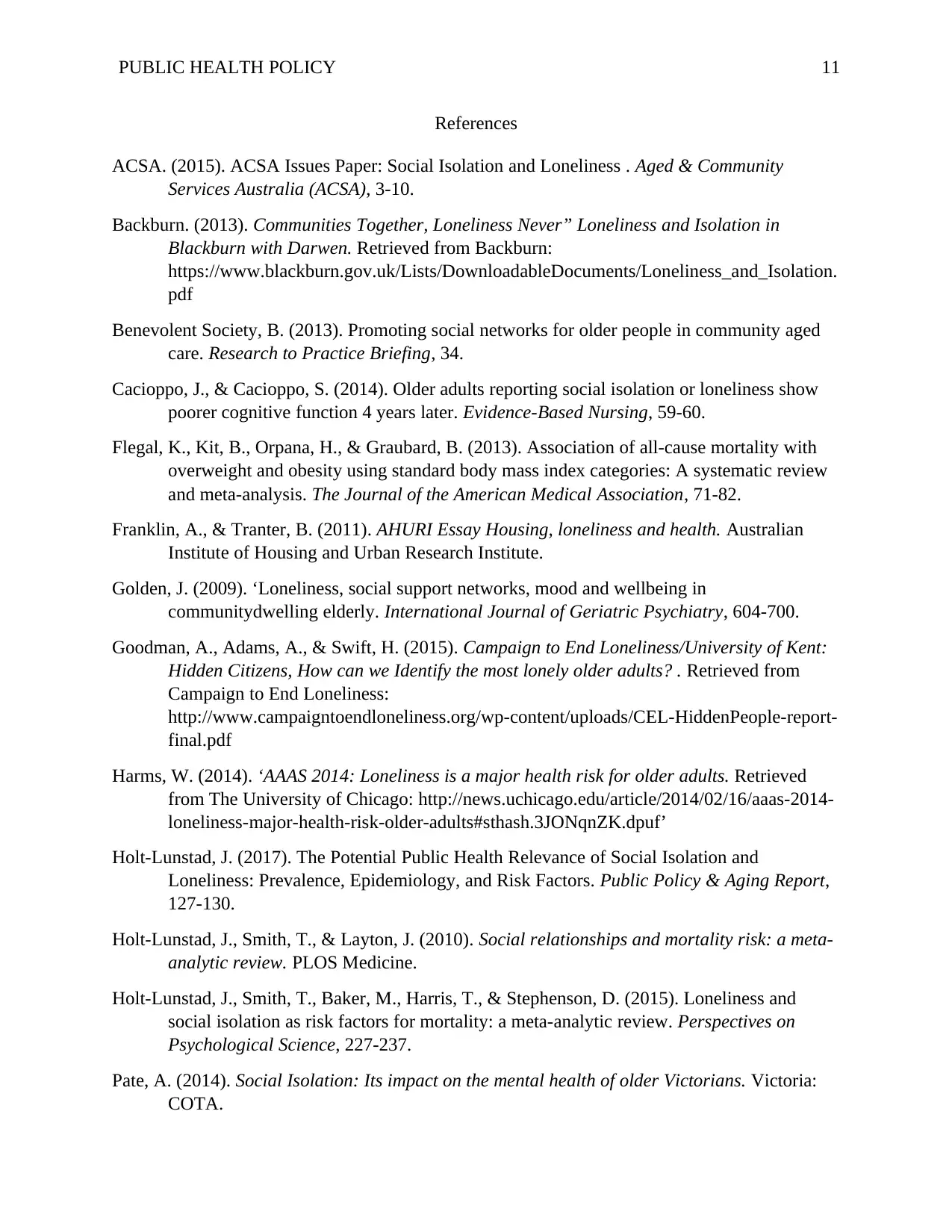
PUBLIC HEALTH POLICY 11
References
ACSA. (2015). ACSA Issues Paper: Social Isolation and Loneliness . Aged & Community
Services Australia (ACSA), 3-10.
Backburn. (2013). Communities Together, Loneliness Never” Loneliness and Isolation in
Blackburn with Darwen. Retrieved from Backburn:
https://www.blackburn.gov.uk/Lists/DownloadableDocuments/Loneliness_and_Isolation.
pdf
Benevolent Society, B. (2013). Promoting social networks for older people in community aged
care. Research to Practice Briefing, 34.
Cacioppo, J., & Cacioppo, S. (2014). Older adults reporting social isolation or loneliness show
poorer cognitive function 4 years later. Evidence-Based Nursing, 59-60.
Flegal, K., Kit, B., Orpana, H., & Graubard, B. (2013). Association of all-cause mortality with
overweight and obesity using standard body mass index categories: A systematic review
and meta-analysis. The Journal of the American Medical Association, 71-82.
Franklin, A., & Tranter, B. (2011). AHURI Essay Housing, loneliness and health. Australian
Institute of Housing and Urban Research Institute.
Golden, J. (2009). ‘Loneliness, social support networks, mood and wellbeing in
communitydwelling elderly. International Journal of Geriatric Psychiatry, 604-700.
Goodman, A., Adams, A., & Swift, H. (2015). Campaign to End Loneliness/University of Kent:
Hidden Citizens, How can we Identify the most lonely older adults? . Retrieved from
Campaign to End Loneliness:
http://www.campaigntoendloneliness.org/wp-content/uploads/CEL-HiddenPeople-report-
final.pdf
Harms, W. (2014). ‘AAAS 2014: Loneliness is a major health risk for older adults. Retrieved
from The University of Chicago: http://news.uchicago.edu/article/2014/02/16/aaas-2014-
loneliness-major-health-risk-older-adults#sthash.3JONqnZK.dpuf’
Holt-Lunstad, J. (2017). The Potential Public Health Relevance of Social Isolation and
Loneliness: Prevalence, Epidemiology, and Risk Factors. Public Policy & Aging Report,
127-130.
Holt-Lunstad, J., Smith, T., & Layton, J. (2010). Social relationships and mortality risk: a meta-
analytic review. PLOS Medicine.
Holt-Lunstad, J., Smith, T., Baker, M., Harris, T., & Stephenson, D. (2015). Loneliness and
social isolation as risk factors for mortality: a meta-analytic review. Perspectives on
Psychological Science, 227-237.
Pate, A. (2014). Social Isolation: Its impact on the mental health of older Victorians. Victoria:
COTA.
References
ACSA. (2015). ACSA Issues Paper: Social Isolation and Loneliness . Aged & Community
Services Australia (ACSA), 3-10.
Backburn. (2013). Communities Together, Loneliness Never” Loneliness and Isolation in
Blackburn with Darwen. Retrieved from Backburn:
https://www.blackburn.gov.uk/Lists/DownloadableDocuments/Loneliness_and_Isolation.
Benevolent Society, B. (2013). Promoting social networks for older people in community aged
care. Research to Practice Briefing, 34.
Cacioppo, J., & Cacioppo, S. (2014). Older adults reporting social isolation or loneliness show
poorer cognitive function 4 years later. Evidence-Based Nursing, 59-60.
Flegal, K., Kit, B., Orpana, H., & Graubard, B. (2013). Association of all-cause mortality with
overweight and obesity using standard body mass index categories: A systematic review
and meta-analysis. The Journal of the American Medical Association, 71-82.
Franklin, A., & Tranter, B. (2011). AHURI Essay Housing, loneliness and health. Australian
Institute of Housing and Urban Research Institute.
Golden, J. (2009). ‘Loneliness, social support networks, mood and wellbeing in
communitydwelling elderly. International Journal of Geriatric Psychiatry, 604-700.
Goodman, A., Adams, A., & Swift, H. (2015). Campaign to End Loneliness/University of Kent:
Hidden Citizens, How can we Identify the most lonely older adults? . Retrieved from
Campaign to End Loneliness:
http://www.campaigntoendloneliness.org/wp-content/uploads/CEL-HiddenPeople-report-
final.pdf
Harms, W. (2014). ‘AAAS 2014: Loneliness is a major health risk for older adults. Retrieved
from The University of Chicago: http://news.uchicago.edu/article/2014/02/16/aaas-2014-
loneliness-major-health-risk-older-adults#sthash.3JONqnZK.dpuf’
Holt-Lunstad, J. (2017). The Potential Public Health Relevance of Social Isolation and
Loneliness: Prevalence, Epidemiology, and Risk Factors. Public Policy & Aging Report,
127-130.
Holt-Lunstad, J., Smith, T., & Layton, J. (2010). Social relationships and mortality risk: a meta-
analytic review. PLOS Medicine.
Holt-Lunstad, J., Smith, T., Baker, M., Harris, T., & Stephenson, D. (2015). Loneliness and
social isolation as risk factors for mortality: a meta-analytic review. Perspectives on
Psychological Science, 227-237.
Pate, A. (2014). Social Isolation: Its impact on the mental health of older Victorians. Victoria:
COTA.
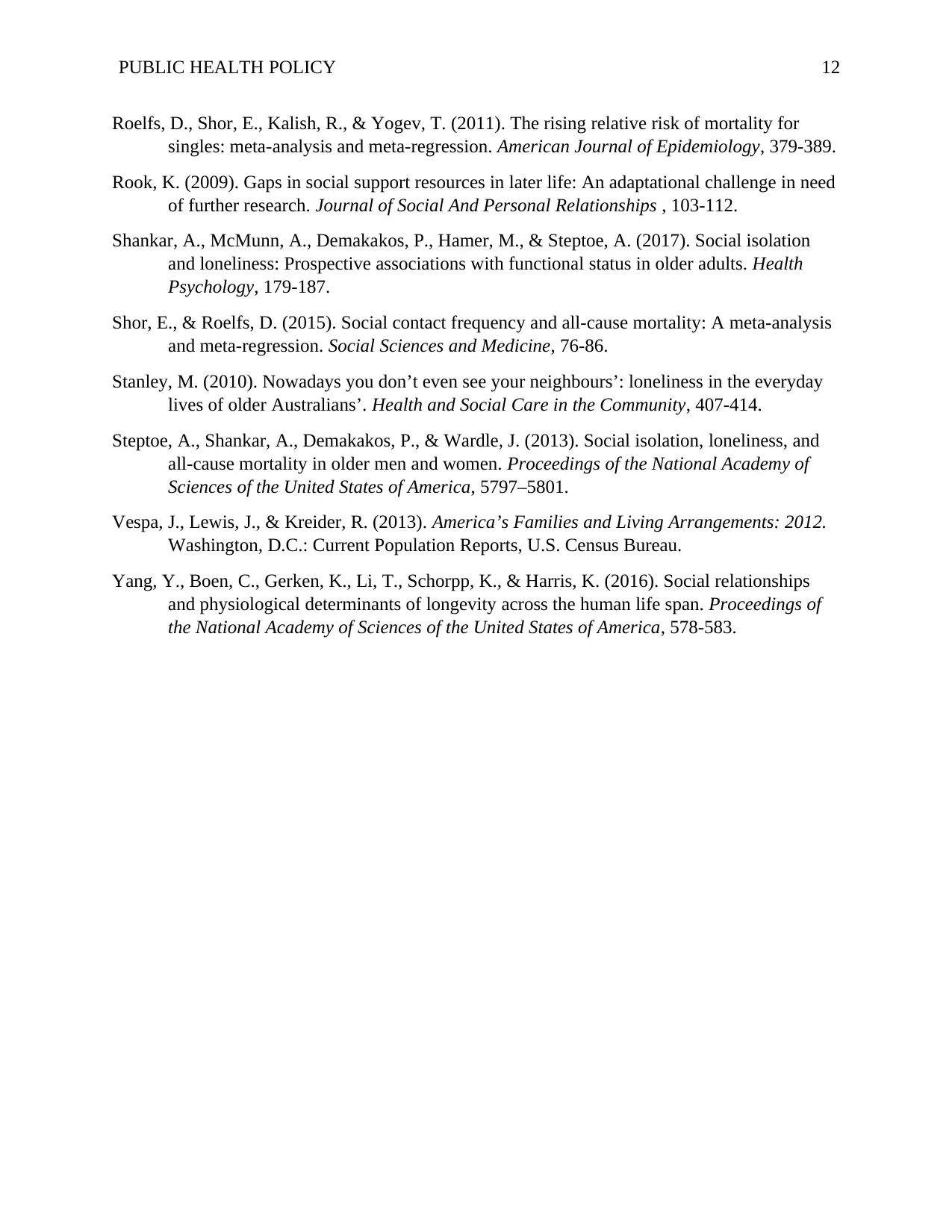
PUBLIC HEALTH POLICY 12
Roelfs, D., Shor, E., Kalish, R., & Yogev, T. (2011). The rising relative risk of mortality for
singles: meta-analysis and meta-regression. American Journal of Epidemiology, 379-389.
Rook, K. (2009). Gaps in social support resources in later life: An adaptational challenge in need
of further research. Journal of Social And Personal Relationships , 103-112.
Shankar, A., McMunn, A., Demakakos, P., Hamer, M., & Steptoe, A. (2017). Social isolation
and loneliness: Prospective associations with functional status in older adults. Health
Psychology, 179-187.
Shor, E., & Roelfs, D. (2015). Social contact frequency and all-cause mortality: A meta-analysis
and meta-regression. Social Sciences and Medicine, 76-86.
Stanley, M. (2010). Nowadays you don’t even see your neighbours’: loneliness in the everyday
lives of older Australians’. Health and Social Care in the Community, 407-414.
Steptoe, A., Shankar, A., Demakakos, P., & Wardle, J. (2013). Social isolation, loneliness, and
all-cause mortality in older men and women. Proceedings of the National Academy of
Sciences of the United States of America, 5797–5801.
Vespa, J., Lewis, J., & Kreider, R. (2013). America’s Families and Living Arrangements: 2012.
Washington, D.C.: Current Population Reports, U.S. Census Bureau.
Yang, Y., Boen, C., Gerken, K., Li, T., Schorpp, K., & Harris, K. (2016). Social relationships
and physiological determinants of longevity across the human life span. Proceedings of
the National Academy of Sciences of the United States of America, 578-583.
Roelfs, D., Shor, E., Kalish, R., & Yogev, T. (2011). The rising relative risk of mortality for
singles: meta-analysis and meta-regression. American Journal of Epidemiology, 379-389.
Rook, K. (2009). Gaps in social support resources in later life: An adaptational challenge in need
of further research. Journal of Social And Personal Relationships , 103-112.
Shankar, A., McMunn, A., Demakakos, P., Hamer, M., & Steptoe, A. (2017). Social isolation
and loneliness: Prospective associations with functional status in older adults. Health
Psychology, 179-187.
Shor, E., & Roelfs, D. (2015). Social contact frequency and all-cause mortality: A meta-analysis
and meta-regression. Social Sciences and Medicine, 76-86.
Stanley, M. (2010). Nowadays you don’t even see your neighbours’: loneliness in the everyday
lives of older Australians’. Health and Social Care in the Community, 407-414.
Steptoe, A., Shankar, A., Demakakos, P., & Wardle, J. (2013). Social isolation, loneliness, and
all-cause mortality in older men and women. Proceedings of the National Academy of
Sciences of the United States of America, 5797–5801.
Vespa, J., Lewis, J., & Kreider, R. (2013). America’s Families and Living Arrangements: 2012.
Washington, D.C.: Current Population Reports, U.S. Census Bureau.
Yang, Y., Boen, C., Gerken, K., Li, T., Schorpp, K., & Harris, K. (2016). Social relationships
and physiological determinants of longevity across the human life span. Proceedings of
the National Academy of Sciences of the United States of America, 578-583.
⊘ This is a preview!⊘
Do you want full access?
Subscribe today to unlock all pages.

Trusted by 1+ million students worldwide
1 out of 12
Related Documents
Your All-in-One AI-Powered Toolkit for Academic Success.
+13062052269
info@desklib.com
Available 24*7 on WhatsApp / Email
![[object Object]](/_next/static/media/star-bottom.7253800d.svg)
Unlock your academic potential
Copyright © 2020–2025 A2Z Services. All Rights Reserved. Developed and managed by ZUCOL.





